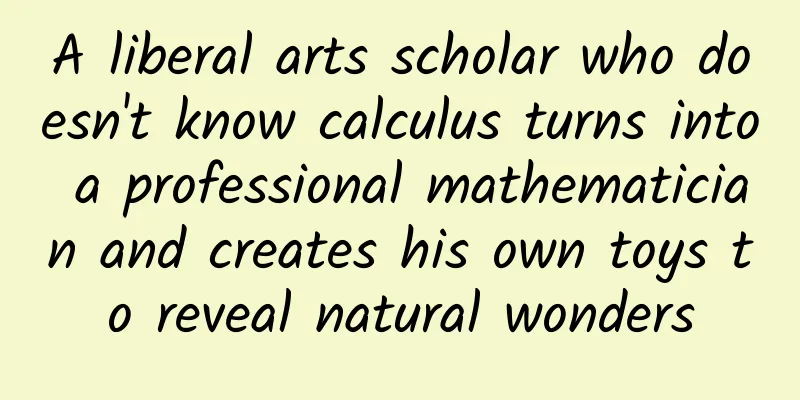A liberal arts scholar who doesn't know calculus turns into a professional mathematician and creates his own toys to reveal natural wonders

|
I don't think my life is unconventional. Of course, if you force me to fit into a standard lifestyle in society, then I am a maverick. It's just a matter of choosing a coordinate system. If you use the wrong coordinate axis, things will become very complicated. ... I live my life in my own way every day and never try to do anything out of the ordinary - everything is so natural and natural. ——Tokieda Masaru Compiled by Xiaoye He started painting in his childhood, went to study abroad alone as a teenager, learned at least four foreign languages in one go, gave up his stable job in his twenties, returned to university to switch to mathematics, and is now a mathematics professor at Stanford University in the United States. Tadashi Tokieda, known as a "magic" mathematician, has walked a magical path in life. His teaching method is also like magic: the jar will not roll down the slope, the paper can "pass" through the finger... Simple "toys" in the classroom make abstract mathematical and physical principles vivid and interesting. A career path full of twists and turns Masaru Tokieda was born in Japan in the late 1960s. He had artistic talent since childhood and held a solo exhibition at a large gallery in Tokyo when he was 5 years old. It is said that a couple from Hawaii took a fancy to one of his still life paintings and was willing to pay a high price for it, but was rejected by Masaru Tokieda's mother. He almost sold his first work in his first exhibition, and everyone thought he would definitely become a painter. However, Tokieda was unwilling to settle for a life that followed the rules, but instead yearned for the culture and atmosphere of a foreign country. So, at the age of fourteen, the shy boy made a bold decision - he successfully persuaded his parents to let him go to France to study in high school alone. This decision made his life change for the first time. Although Japanese schools teach foreign languages, for Tokieda at the time, it was just a course, which only stayed at a list of words and a line of grammar rules. Not only was the method rigid, but it could not be connected with a rich and passionate life. "In Japan, we learn something called English, but it is just a course. Can you really live in this language? Can you fall in love, raise children, and face death in this language? Obviously not." In France, he immersed himself in the local culture and quickly learned French, which also made his originally introverted self more cheerful. In addition to French, he also compiled a set of Spanish teaching materials by himself. Combined with grammar books, it didn't take long for him to communicate fluently with his friends in Spanish. Tokieda completed a bachelor's and master's degree in classical linguistics in France and Japan, and worked as a linguistics lecturer in Tokyo after graduation. However, linguistics is not Tokieda's ultimate goal. When writing a paper, he accidentally read a biography, in which a calculus problem changed his career path again. The protagonist of the biography is the legendary Soviet physicist and Nobel Prize winner Lev Davidovich Landau, who is well-known to everyone. What makes Tokieda most ashamed is that he claims to have received a good higher education, but in fact, like most people, he knows nothing about mathematics, and does not even know that "science exists as a human endeavor", "What is a mathematician? What is a physicist?" It seems to be just a distant concept, "not existing in real life." The photo was taken in 1962. Rolf Sulman (left), the Swedish ambassador to the former Soviet Union, awarded Landau (right) the Nobel Prize in Physics medal and certificate in Moscow on behalf of the Nobel Prize Committee. That year, Landau was injured in a car accident and was unable to go to Stockholm to receive the Nobel Prize in person. So, in order to prove that he could also learn mathematics, Tokieda Masaru decided to follow the mathematics learning method taught by Landau in his biography: find a mathematics book with the most exercises and do them carefully. He followed the instructions and found a complete collection of mathematics problems. The book was written in Russian, and Tokieda Masaru was not fluent in Russian, but for linguists, it was not difficult to master another foreign language. He spent the entire winter doing this, and after about a month and a half, he successfully solved Landau's calculus problem. From then on, Masaru was unstoppable. He was convinced that he was talented and good at mathematics, so he resolutely decided to embark on the career path of becoming a mathematician. He left his teaching position and went to Oxford University to re-enter the undergraduate program to study mathematics. At Oxford, as long as you are "rolling" enough, you can complete your undergraduate studies in two years, which is the most suitable "shortcut" for Tokieda Masaru. Although he started studying at the "advanced age" of just over 20, his hard work paid off. He not only successfully completed his studies, but also continued his studies and eventually obtained a Ph.D. in mathematics from Princeton University in the United States, becoming a real "mathematical researcher" in real life. Masaru Tokieda said that mathematics has two major charms that attracted him to this path. When he was still in Tokyo, Masaru Tokieda sometimes went to the university to attend mathematics lectures, where he experienced an unprecedented academic culture shock: a student stood up and interrupted the explanation, pointing out that the professor might have made a mistake. The professor looked at the blackboard, pondered for a moment, and said, "Ah, yes. I was wrong, you are right." Masaru Tokieda recalled: "It was amazing to hear a decent adult say this, and everyone was as usual!" Such a situation is quite rare in the field of humanities. Taking Masaru Tokieda's academic experience in linguistics as an example, academic content must be right or wrong, but even if there is a mistake, for various reasons, scholars rarely admit that they are wrong, and students need to use more clever statements to point it out euphemistically. Mathematics never "whitewashes its mistakes", and Masaru Tokieda greatly appreciates this. He knows that making mistakes is also a privilege, and every mistake or falsification will become an opportunity for learning and discovery. In addition, although mathematics is difficult, it is not completely impossible to learn. On the contrary, this subject has never deliberately made it difficult for learners. For more than two thousand years, countless brilliant mathematicians in history have worked hard to establish a mathematical system and rigorous mathematical logic. After generations of mathematicians have continuously reorganized and reconstructed it, the entire mathematical discipline is now clear. All of this makes mathematics easier to understand and master. Tokieda Masaru's personal mathematical practice also proves that if you can master the correct mathematical learning method, study in an organized and logical manner, persevere, and have a little luck, you will eventually achieve something. From pure mathematician to "magic" scientist Whether engaged in art, linguistics or science, there are similarities among the three: artists and scholars like to talk about their work, and the content is not about specific mathematical formulas, but about their motivations and methods for solving specific problems. For this reason, Tokieda encountered a lot of troubles at the beginning. At the beginning of his mathematical research career, Tokieda studied a very pure field of mathematics: symplectic topology, a branch of differential geometry that originated from the Hamiltonian representation of classical mechanics. Its research object is symplectic manifolds, that is, differential manifolds with closed non-degenerate 2-forms. For people who are not in the field of mathematics, the above passage is no different from a book of heaven. This also made Tokieda Masaru quite troubled. He could not share his work results with friends or family outside the field, nor could he let them experience the surprise of scientific discovery. He admitted that mathematics cannot be understood at first glance, but requires a second or even a third glance. Tokieda Masaru understands the pain of not understanding very well. Therefore, he thought that if he could explain the introductory principles in a relaxed, humorous, and even somewhat "foolproof" way, he could guide students into the world of mathematics. In 2023, at the invitation of the École Normale Supérieure and the Paris Sciences et Lettres University (École normale supérieure - PSL), Tokieda gave a unique lecture. In this popular science lecture on topology, there was no blackboard covered with formulas, only a camera and a small desk. Tokieda took out the prepared long paper strips and began to demonstrate. He connected the two ends of the paper strips, creating ordinary paper rings and Möbius rings in succession, and then interlocked them and cut them along the center line. Then something magical happened. Some double linked rings became squares after being cut, while others became "heart-to-heart". While demonstrating the magic of paper rings, Tokieda talked about the topological properties behind it. The audience watched intently, and the abstract and profound concepts became concrete and vivid before their eyes. During his postdoctoral period, Tokieda began to teach himself physics. Unlike the high abstraction of mathematics, physics is relatively more concrete and tangible, especially some physical phenomena in daily life, which fascinated him deeply. Therefore, Tokieda decided that whenever he wrote a paper or figured out a phenomenon, he would use some simple objects at hand to design relevant desktop experiments, show them to people anytime and anywhere, and share the joy he got in the process of scientific discovery. This also formed his unique teaching style in the future. He often gave up the commonly used slides and large-scale blackboard writing, and instead used cameras and "toys" to weave interesting and meaningful stories, telling complex scientific theories in a fascinating way. Yes, the "toys" that Tokieda Masaru values are not the complex and exquisite goods displayed in toy stores. He believes that those will only make people slaves to the toys and can only play according to the rules set by the toy developers. On the contrary, the "toys" collected by Tokieda Masaru seem very ordinary: white paper, cups, spoons, electric toothbrushes, bolts... But if you follow the rules of nature to manipulate these simple objects, they will show surprisingly complex behaviors and present a "magical" effect. This also brought him the reputation of a "magic" scientist. One of his favorite "magic" demonstrations was the "Toy Models" lecture at the Institute for Advanced Study in Princeton, USA in 2014, in which he demonstrated several "small toys" he developed himself, one of which used common soup bowls and small wooden balls in the home. In the lecture video, Tokieda puts a small wooden ball into an empty soup bowl, then shakes the bowl clockwise. At this time, the small wooden ball is hit by the bowl wall and begins to roll along the bowl wall in the same clockwise direction. Then he adds the second, third, and fourth small wooden balls. These small wooden balls are independent of each other and also roll together in the clockwise direction. However, when the number of wooden balls increases to the fifth and sixth, they seem to start "fighting" with each other, and their motion trajectories become chaotic. When the seventh ball is added, a strange phenomenon occurs. The movement of the wooden balls is no longer chaotic, and they begin to roll in the opposite direction to before. This is exactly the "Toy model of phase transition" established by Tokieda: as the wooden balls become more and more crowded, the translational motion (linear momentum) of the wooden balls caused by the collision with the bowl wall is increasingly dissipated by the collision between the wooden balls, and the rotation (angular momentum) of the wooden balls caused by the friction of the bowl wall gradually replaces it and becomes dominant. This is actually somewhat similar to the phase transition process of steam condensing into liquid water: the water molecules become more and more crowded, and the interactions become stronger and stronger, resulting in a significant change in the overall state and behavior. You can also see that if you continue to add small wooden balls, all of them will eventually squeeze together and become motionless like "ice". To date, Tokieda has collected and invented hundreds of "toys": from rotating plastic tubes to small gyroscopes, from Slinkys that demonstrate tension and gravity to "musical instruments" that make sounds by tapping cups and spoons, to glass jars filled with rice that roll along a slope at different speeds depending on the amount of rice, and so on. All these interesting displays guide people into the magical yet not mysterious world of science. Sometimes, people confuse Tokieda’s “toys” with things like jigsaw puzzles and Rubik’s Cubes, but he disagrees: “I’m not interested in games with artificially set rules. I’m concerned with the uncanny craftsmanship of nature’s laws.” The more complex and difficult “artificial” puzzles such as jigsaw puzzles and Rubik’s Cubes are, the better, in order to make them difficult for others to crack. But Tokieda yearns for the simplicity of nature, hoping to discover truly beautiful and amazing things in it - without artificial barriers, children and scientists can share the same surprises. Tokieda said that we should look at the world through the eyes of children. He found that adults sometimes have a regrettable tendency: they are only interested in things that the public is enthusiastic about, but innocent children are different. They are fresh and curious about everything. No matter whether others pay attention to it or find it interesting, children can always find things that surprise themselves. Tokieda did exactly this. When washing his hands, he noticed that if the faucet flows out a steady and thin stream of water, when the finger slowly approaches the outlet along the water flow, the water flow will show ripples like water droplets. This phenomenon can be explained by the principle of surface tension, but most adults often ignore this common and "unusual" natural phenomenon. At the end of the lecture, a very common question from the audience was: "What practical uses do these demonstrations have?" Tokieda asked them what the so-called "practical uses" were. The answers he collected were summarized into two types: either becoming rich overnight or having the power of life and death. "In fact, many people were surprised by their own answers." Tokieda's own answer was not among them. He told the audience that science is not just something that a group of experts in white coats do in cold laboratories. On the contrary, it is lively, fun, and everywhere. "I don't know what other people think, but my toys do have a use: when I show my toys to children, they look very happy. If this is not a practical use, then what is?" Special Tips 1. Go to the "Featured Column" at the bottom of the menu of the "Fanpu" WeChat public account to read a series of popular science articles on different topics. 2. Fanpu provides a function to search articles by month. Follow the official account and reply with the four-digit year + month, such as "1903", to get the article index for March 2019, and so on. Copyright statement: Personal forwarding is welcome. Any form of media or organization is not allowed to reprint or excerpt without authorization. For reprint authorization, please contact the backstage of the "Fanpu" WeChat public account. |
Recommend
GDC 2016: Helmets aren't the biggest challenge facing VR games
This week, GDC kicked off in San Francisco, USA. ...
Marketing tricks for Children's Day topics!
Let’s talk about how to do topic marketing on Chi...
Can sitting kill you? People who sit for long periods of time should beware of blood clots
Time flies, flowers may bloom again, but people c...
[Practical Tips] Six major application markets teach you how to run the Android market!
Some optimization techniques for the domestic And...
How much does it cost for Atel to join a fast food mini program?
How much does it cost to join a fast food app in ...
Is KMS dangerous? How is the genuine version of Windows different from the pirated one?
Microsoft's former CEO Ballmer once criticize...
The cancellation of roaming charges for mobile phones in Beijing, Tianjin and Hebei has not yet been implemented, and intra-city communication has become a trend
After five years of difficulties, the Beijing-Tia...
What? Not only is there no New Year's Eve this year, but even the Nian beast is gone?
Whenever the Lunar New Year approaches, the legen...
How much does it cost to make a hardware app in Quzhou? What is the quotation for the production of Quzhou hardware mini program?
There is no doubt that the topic of mini programs...
8 short video transaction scripts
You may have spent thousands of dollars listening...
Every designer can’t help but recommend these five Sketch plugins!
Whether it is Sketch Runner, which can quickly ru...
A low-cost guide to marketing on Xiaohongshu!
A friend who is in the branding business asked: H...
Practical experience | Talk about the two doors of offline event promotion
Today we are discussing the data problems encount...
Street hotpot is "going viral", beware of "table bombs"! Safety reminder for gas stoves →
A gas stove, an iron pot, a folding table, a few ...
The slowest flying aircraft? Uncovering the art of F1D's extreme slow flying
F1 pursues speed, but do you know what F1D pursue...









